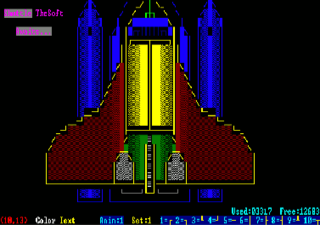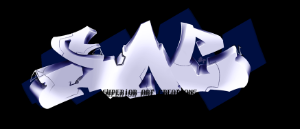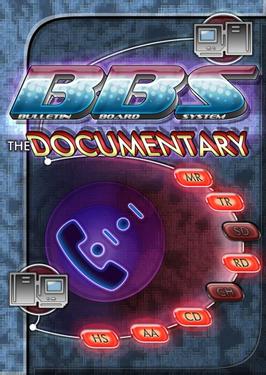
ASCII art is a graphic design technique that uses computers for presentation and consists of pictures pieced together from the 95 printable characters defined by the ASCII Standard from 1963 and ASCII compliant character sets with proprietary extended characters. The term is also loosely used to refer to text-based visual art in general. ASCII art can be created with any text editor, and is often used with free-form languages. Most examples of ASCII art require a fixed-width font such as Courier for presentation.
The computer art scene, or simply artscene, is the community interested and active in the creation of computer-based artwork.

.nfo is a filename extension for text files that accompany warez scene releases of pirated software or media.
ACiD Productions (ACiD) is a digital art group. Founded in 1990, the group originally specialized in ANSI artwork for bulletin board systems (BBS). More recently, they have extended their reach into other graphical media and computer software development. During the BBS-era, their biggest competitor was iCE Advertisements.

The Kosmic Free Music Foundation was a worldwide group of computer musicians, artists, and coders focused on the PC demoscene. Most members were from the United States, Canada, and Australia. They created music—mostly techno, trance, and ambient—with tracker software. They also created some artwork and demos. All their productions were available to download without charge from BBSes and the internet. In the 1990s, they were known for having many of the tracking scene's top musicians as members. Their early presence on the Internet made them one of the first netlabels. The leader of Kosmic was Dan Nicholson, who went by the alias Maelcum.
Christian Wirth, better known by the pseudonym RaD Man, is an American computer artist and historian. He works in the field of ANSI art, a method of creating art using a limited set of text characters and color escape codes based loosely on the relevant ANSI standard.
ANSI art is a computer art form that was widely used at one time on bulletin board systems. It is similar to ASCII art, but constructed from a larger set of 256 letters, numbers, and symbols — all codes found in IBM code page 437, often referred to as extended ASCII and used in MS-DOS and Unix environments. ANSI art also contains special ANSI escape sequences that color text with the 16 foreground and 8 background colours offered by ANSI.SYS, an MS-DOS device driver loosely based upon the ANSI X3.64 standard for text terminals. Some ANSI artists take advantage of the cursor control sequences within ANSI X3.64 in order to create animations, commonly referred to as ANSImations. ANSI art and text files which incorporate ANSI codes carry the de facto.ANS file extension.
An artpack is an archive of computer artwork which is distributed in a compressed format such as ZIP or RAR.

TheDraw is a text editor for MS-DOS to create ANSI and animations as well as ASCII art. The editor is especially useful to create or modify files in ANSI format and text documents, which use the graphical characters of the IBM ASCII code pages, because they are not supported by Microsoft Windows anymore. The first version of the editor was developed in 1986 by Ian E. Davis of TheSoft Programming Services. The last public version of the editor was version 4.63, which was released in October 1993.

Superior Art Creations (SAC) is an underground artscene group which caters primarily to and is well known within the warez scene. SAC members have made, besides ANSI and ASCII art, VGA bitmap graphics, tracker music, and a variety of other works. SAC's character graphics have also been used in bottles and FTP servers.

BBS: The Documentary is a 3-disc, 8-episode documentary about the subculture born from the creation of the bulletin board system (BBS) filmed by computer historian Jason Scott of textfiles.com.

Soulz at Zero (SAZ) was a lit group formed in 1994 by Jack Flack and The Stranger. SAZ released 25 monthly packs over a period of two years, beginning in September 1994 and ending in September 1996. The group took its name from a Souls at Zero poster Flack had in his bedroom at the time, with the trailing "s" in "Souls" changed to a "z". Soulz at Zero was so well known that their name was added to the "Elite Acronym List," which was used to separate "lamers" from "elite users."

Creators of Intense Art, or Cia was an underground computer artscene group that primarily released ANSI, ASCII, and high resolution artwork from 1993 to 2001. Along with iCE and ACiD, Cia was one of the most active, and longest lasting groups on the artscene.
Digital Artists of a Rare Kind, later known as Dark Illustrated, or simply Dark was an underground computer artscene group that primarily released ANSI, ASCII, and high resolution artwork from 1994 to 1999. Though the organization did not operate as long as ACiD, iCE, or CiA, Dark was a very influential and critically successful group. Dark was especially popular with Canadian ANSI artists, who made up a large portion of the member base.
Blade, also referred to as The Blade Nation, was an underground computer artscene group that primarily released ANSI, ASCII, and high resolution artwork from 1994 to 1997, and during a brief time in 1998.

Fire, later known as Fire Graphics, was an underground computer artscene group that released ANSI, ASCII, and high resolution artwork from 1994 to 1998.
This is a list of the minor computer underground artscene groups spanning from roughly 1992 to the present day.

textfiles.com is a website dedicated to preserving the digital documents that contain the history of the bulletin board system (BBS) world and various subcultures, and thus providing "a glimpse into the history of writers and artists bound by the 128 characters that the American Standard Code for Information Interchange (ASCII) allowed them". The site categorizes and stores thousands of text files, primarily from the 1980s, but also contains some older files and some that were created well into the 1990s. A broad range of topics is presented, including anarchy, art, carding, computers, drugs, ezines, freemasonry, computer games, hacking, phreaking, politics, computer piracy, sex, and UFOs. The site was created and is run by Jason Scott.
DeviantArt is an online art community that features artwork, videography and photography, launched on August 7, 2000 by Angelo Sotira, Scott Jarkoff, and Matthew Stephens among others.
Aces of ANSI Art was the first group of artists specifically organized for the purposes of creating and distributing ANSI art. The group was founded and operated by two BBS enthusiasts from California, "Zyphril" and "Chips Ahoy", from 1989 through 1991.











